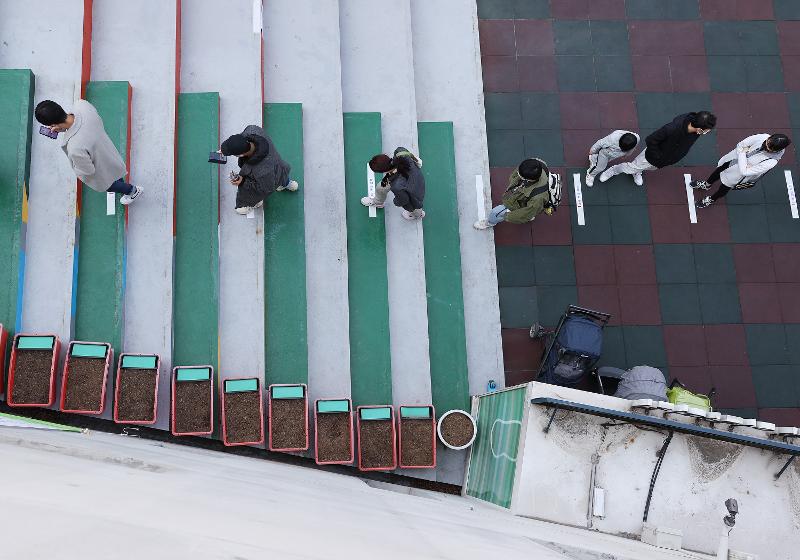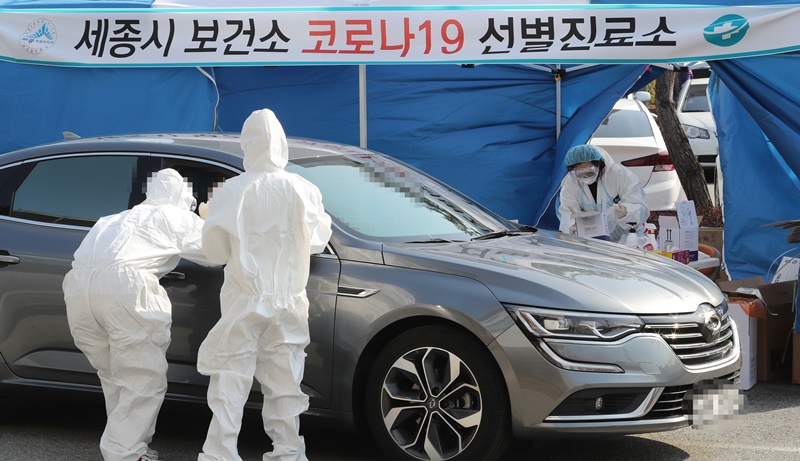Korea.net reflects on the past year of what Prime Minister Chung Sye-kyun called "unending battles and challenges" by reviewing the leading keywords and figures of the pandemic era in this two-part feature.
By Kim Minji, Kim Hyelin and Lee Hana
Photos = Yonhap News

Voters on April 10 last year practice social distancing while lining up to cast their ballots early in the general elections at a community center in Seoul's Seongdong-gu District. (Yonhap News)
KDCA Commissioner Jeong Eun-kyeong
A symbol of Korea's response to COVID-19, Commissioner Jeong has grown synonymous with the country's quarantine efforts. Early after the pandemic broke out from Jan. 30 to Feb. 28, she briefed the public daily on the spread of the coronavirus, and her calm delivery and detailed information earned her the public's trust. When the Korean Centers for Disease Control and Prevention (KCDC) in September last year was upgraded to the Korea Disease Control and Prevention Agency (KDCA), she was appointed the agency's first chief.
Earning the nickname "commander of Korea's quarantine warfare," the commissioner attracted heavy foreign media attention. She was named one of the BBC's 100 most influential women of the year and made Time magazine's list of the world's 100 most influential people.
Test kits
Korea on Jan. 31 last year adopted a testing method using DNA called real-time RT-PCR, thus making mass testing and rapid diagnosis a key component in the government's response to the pandemic. This kit was adopted 18 days after the KCDC announced the launch of development of a testing method for COVID-19. The RT-PCR system needs just six hours to diagnose a patient using samples collected from the nose and mouth, far faster than previous methods requiring 24 hours.
In December last year, this domestically developed method for COVID-19 screening was adopted as an international standard. A month before that, an estimated 496.79 million kits were exported to over 170 countries. The Korea Customs Service said these exports amounted to KRW 2.5 trillion in revenue for the companies that sold them.
Social distancing
Social distancing was introduced as a social campaign to contain the coronavirus, but as the pandemic spread, the Central Disaster and Safety Countermeasures Headquarters in June implemented a three-tier system of social distancing based on the infection rate and quarantine measures. The system determines if schools can open, the operating hours of restaurants and cafes, and how many people can gather in one space. In November last year, the intermediate levels of 1.5 and 2.5 were added to make it a five-tier system.
As of Jan. 20, the social distancing level was 2.5 for the Seoul metropolitan region and 2 for the rest of the country.

Medical professionals in hazmat suits in February last year collect samples at a drive-thru testing clinic set up at a public health center in the administrative city of Sejong. (Yonhap News)
Untact (noncontact)
The pandemic led to the coining of the term "untact" in Korea, a combination of the prefix "un" and the word "contact" to describe doing things without direct contact with other people.
Due to COVID-19, art activities had to be done through noncontact interactions, museums and galleries turned to virtual reality and video exhibitions, and concerts were also forced to go online. Companies allowed staff to telecommute and schools had teachers conduct classes from home. Meetings were held through videoconferencing, and students took part in e-learning classrooms.
The French daily Le Monde on Sept. 23 ran the feature story headlined "Building a contactless world amid the coronavirus," saying, "In Korea, 'contactless society' is no longer science fiction and has grown even more widespread with the COVID-19 pandemic."
Drive- & walk-thru screening clinics
In February last year, when Korea was seeing a rapid rise in COVID-19 infections with Daegu as the epicenter, the government achieved a world first by introducing drive-thru screening clinics. Not only did this method make it more convenient to get tested, it also reduced the risk of infection.
Three months later, walk-thru screening clinics for people arriving on foot also debuted to allow testing in just three minutes and confirmation of the results within 24 hours. This technology uses switching between negative and positive pressure modes in both directions to remove the risk of infection.
Those suspected of having contracted COVID-19 simply walk into a facility shaped like a phone booth for testing, after which a medical professional uses gloves attached to the screen to collect samples from the testee.
kimmj7725@korea.kr